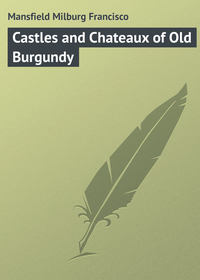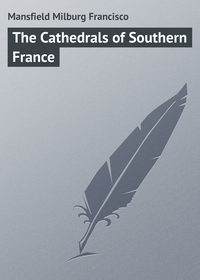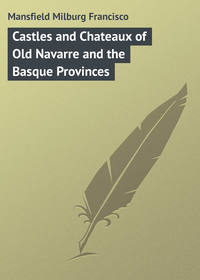 полная версия
полная версияThe Cathedrals of Northern France
Romanesque is plainly noticeable in mixture with the early Gothic. The three portals are not remarkable, or uniform, and are severely plain, and, though of a noticeable receding depth, are bare and unpeopled. A well-proportioned rose window, though not so large as many in the greater cathedrals, has graceful radiating spokes and good glass. This is flanked by two unpierced lancet-pointed window-frames which but accentuate the plainness of the entire façade. Above is an arcaded gallery which was intended to cross the entire front, but which now stops where the gable joins the northerly tower. Restoration has been carried on, not sparingly, but in good taste, with the result that, in spite of its newness at the present writing, it appears as a consistent and thoroughly conscientious piece of work, and not the mere patchwork that such repairs usually suggest.
The guide-books tell one that Soissons is famous for its trade in haricot beans, and incidentally for the beans themselves, and for the great number of sieges which it has undergone, the last being that conducted by the Germans, who took possession in October, 1870, after a bombardment of three days.
Fergusson makes the statement, which is well taken, that the Cathedral of Notre Dame de Soissons, while not in any sense meriting the term magnificent, presents, in its interior arrangements, at least, a most symmetrical and harmonious ensemble. A curious though not unpleasing effect is produced by the blackened pointing of the interior masonry, of piers, walls, and vaulting alike. An unusual feature is the circumambient aisles to the transepts and the suggestion that a trefoil apsidal termination was originally thought of, when the rebuilding was taken in hand in the twelfth century. The transept is so completed on the south side, which possesses also an ancient portal, and, with the two at Noyon so done, presents a feature which is as much a relief from the usual rectangle as are the rounded choirs of Continental churches a beauty in advance of the accepted English manner of treatment of this detail.
The choir rises loftily above the transepts and nave, and, while the general proportions are not such as to suggest undue narrowness, the effect is of much greater height than really exists. This, too, is apparent when viewing the abside itself.
The Chapel of the Rosary in the north transept is overtopped by an effective arrangement of perpendicular window-framing, supporting a beautiful rose window of the spoke variety. It is safe to say that, had the entire space provided been glazed, the effect of lighting would have been unique among the cathedrals of the world.
The only other decorative embellishments are some tapestries, a few well-preserved tombs, and an "Adoration" supposed to be by Rubens, which is perhaps more likely to be genuine, because of the situation of the church near unto Flanders, than many other examples whose claims have even less to support them.
PART II
The Grand Group
I
INTRODUCTORY
Expert opinion, so called, may possibly differ as to just what, or what not, cathedrals of France should be included in this term. The French proverb known of all guide-book makers should give a clue as to those which at least may not be left out.
"Clocher de Chartres, Nef d'AmiensChoeur de Beauvais et Portale de Reims."Rouen, Paris, and Le Mans should be included, as well possibly as the smaller but no less convincing examples at Séez, Sens, Laon, and Troyes, as being of an analogous manner of building, and, by all that goes to make up the components of a really great church, Bourges might well be considered in the same group. For practical and divisional purposes it is perhaps well to compose an octette of the churches of the Isle of France and those lying contiguous thereto, Paris, Beauvais, St. Denis, Amiens, Reims, Rouen, Chartres, and Le Mans, which may be taken together as representative of the greatest art expression of the Gothic builders, as well as being those around which centred the most significant events of Church and State. To attempt to catalogue even briefly the charms and notable attributes of even the first four, would require more than the compass of several volumes the size of the present, whereas the attempt made herein is merely to lead with as little digression as possible up to the chief glories for which they are revered, and to suggest some of the many important and epoch-making events intimately associated therewith. More would be impossible, manifestly, unless the present work were to transcend the limitations which were originally planned for it, hence it is with no halting assertion that we enter boldly upon that chronology or résumé which, in a way, presents a marshalled array of correlated facts which the reader may care to follow in further detail in the list of bibliographical references included at the end of the volume.
Certain facts relating to the history and the architectural features generally of these great cathedrals are known to all, and are chronicled with more or less completeness in many valuable and authoritative works, ranging from the humble though necessary guide-book to the extensive if not exhaustive architectural work of reference. The facts given herein are such, then, as are often overlooked in the before-mentioned classes of works, and as such are presented, not so much with the avowed object of imparting information, as to remind the reader of the wealth of interest that exists with relation to these shrines of religious art. This seems to be the only preamble possible to the chapters which attempt to even classify these magnificent buildings, wherein much is attempted and so little accomplished in recounting their varied attractions. Let this explanation stand, therefore, for any seeming paucity of description which may exist.
II
NOTRE DAME D'AMIENS
The ever impressive Cathedral of Notre Dame d'Amiens is in most English minds the beau ideal of a French cathedral. It is contemporary with Salisbury in period, at least, but it has little to remind one of the actual features of this edifice. Often associated therewith, as a similar type, it has little in reality in common, except that each is representative of a supreme style. Beyond this it is hard to see how any expert, archæologist, antiquary, or what not, would seek to discover relationship between two such distinct types. Salisbury is the ideal English cathedral as to situation, surroundings, and general charm and grace. This no one would attempt to deny; but, in another environment, how different might it not appear, – as for instance placed beside Amiens, where in one particular alone, the mere height of nave and choir, it immediately dwindles into insignificance. Under such conditions its graceful spire becomes dwarfed and attenuated. Need more be said? – The writer thinks not, since the present work does not deal with the comparative merits of any two cathedrals or of national types; but the suggestion should serve to demonstrate how impossible it is for any writer, however erudite he may be, to attempt to assign precedence, or even rank, among the really great architectural works of an era. This observation is true of many other examples of art expression.
The cathedral at Amiens is dedicated to the Virgin, and is built in the general form of a Latin cross. Over the principal doorway of the south portal, on one of the upper plinths, may be seen the inscription which places the date of the present edifice.
The work was undertaken by one Robert de Luzarche, in the episcopate of Evrard de Fouilloy, the forty-fifth Bishop of Amiens, whose tomb may be seen just within the western doorway, and occupies the site of other structures which had been variously devastated by fire or invasion in 850, 1019, 1137, and 1218. For fifty years the work went on expeditiously under various bishops and their architects. "Saint" Louis, Blanche of Castille, Philippe the Hardy, and the city fathers all aided the work substantially, and the fabric speedily took on its finished form. Through the later centuries it still preserved its entity, and even during the Revolution its walls escaped destruction and defilement through the devotion of its adherents.
In later days important work and restoration has been carried out under the paternal care and at the expense of the state; and the city itself only recently contributed 45,000 francs for the clearing away of obstructing buildings.
A French writer has said, "It is only with the aid of a Bible and a history of theology that it is possible to elucidate the vast iconographic display of the marvellous west front of the cathedral at Amiens." Like Reims, its three portals of great size are peopled with a throng of statues. The central portal, known as the Porche du Souvenir, contains the statue of the Good God of Amiens; that on the right is called after the Mère de Dieu, and that on the left for St. Fermin the Martyr. Above the gables is the "Gallery of Kings," just below the enormous rose windows. Above rise the two towers of unequal loftiness, and lacking, be it said, thickness in its due proportion. The carven figures in general are not considered the equal in workmanship of those at Reims, though the effect and arrangement is similar. For a complete list of them, numbering some hundreds on this façade alone, the reader must refer to some local guide-book, of which several are issued in the city.
The south portal, the Portal de la Vierge dorée or Portal de Saint Honoré, shares company with the west façade in its richness of sculpture and its rose window and its gable. Here also are to be seen the supporting buttresses which spring laterally from the wall of the transept and cross with those which come from the choir.
The north portal, on the side of the Bishop's Palace, does not show the same richness as the others, though perhaps more than ordinarily ornate.
The spire above the transept crossing is a work of the sixteenth century, and is perhaps more remarkable than its rather diminutive appearance, in contrast with the huge bulk of the edifice, would indicate.
The extreme height of nave and choir (147 feet), adds immeasurably to the grand effect produced by the interior, a height in proportion to breadth nearly double that usual in the English cathedrals. The vaulting is borne aloft by over one hundred columns. The natural attribute of such great dimension is a superb series of windows, a promise more than fulfilled by the three great rose windows and the lofty clerestory of nave and choir. The sixteenth century glass is exceedingly profuse and brilliant.
The lateral chapels of the nave were added subsequent to the work of the early builders, all being of the sixteenth century, while the eleven choir chapels are of the thirteenth century, all with very ornate iron grilles, which are a feature only second to a remarkable series of "choir stalls," numbering over one hundred, showing a wonderful variety of delicate carved figures of the sixteenth century, the work of one Jean Turpin, the subjects being mainly Biblical.
A stone screen with elaborate sculptures in high relief surrounds the choir, that on the south representing the legend of St. Firmin, the patron of Picardy, and that on the north, scenes connected with the life of John the Baptist. In a side chapel dedicated to St. John reposes the alleged head of John the Baptist. Others have appeared elsewhere from time to time, but as they are not now recognized as being genuine, and the said apostle not being hydra-headed, it is possible that there will be those who will choose to throw the weight of their opinions in favour of the claim of Amiens.
The flying buttresses at Amiens are not of the singular lightness associated with this notably French characteristic; they are in the main, however, none the less effective for that, and assuredly, so far as the work which they have to perform is concerned, it was doubtless necessary that they should be of more than ordinary strength.
The view of the ensemble from the river shows the massiveness and general proportions in a unique and superb manner. Amiens is not otherwise an attractive city, a bustle of grand and cheap hotels, decidedly a place to be taken en route, not like Beauvais, where one may well remain as long as fancy wills and not feel the too strong hand of progress intruding upon his ruminations.
III
ST. PIERRE DE BEAUVAIS
Beauvais is by no means an inaccessible place, though how often have we known one who could not tell in what part of France it was situated. Of course, being "off the line" is sufficient excuse for the majority of hurried travellers to pass it by, but, leaving this debatable point out of the question, let us admit, for the nonce, that it is admirably located if one only chooses to spend a half-day or more in visiting the charmingly interesting city and its cathedral, or what there is of it, for it exists only as a luminous height sans nave, sans tower, and sans nearly everything, except a choir of such immensity that to see it is to marvel if not to admire. It is indeed as Hope has said, "a miracle of loftiness and lightness; appearing as if about to soar into the air."
How many readers, who recognize the charms for which the cathedral is most revered, know that it was intended to rank as the
St. Peter's of the north, and like its Roman prototype, was to surpass all other contemporary structures in size and magnificence. This was marked out for it when, in the middle sixteenth century, the builders of its central spire, which fell shortly after, sought to rival the Italian church in a vast Gothic fabric which should be the dominant northern type in contra-distinction to that of the south. This of itself, were there no other contributory interests, which there are to a very great degree, should be all-sufficient to awaken the desire on the part of every one who journeys Parisward to obtain a more intimate acquaintance with this great work. Here was an instance of ambition overleaping itself, – exceeding by far the needs and conditions of its environment and like many another ill-planned venture, it fell to ruin through a lack of logic and mental balance. To-day we see a restored fabric, lacking all the attributes of a great church except that which is encompassed by that portion lying eastward of the nave proper, its frail buttresses knitted together by iron rods, its piers latterly doubled in number, and many more visible signs of an attempt to hold its walls and roofs up to the work they have to perform.
The present structure, in so far as certain of its components go, was commenced within five years of Amiens (1225), which calls to mind the guide-book comparison, which seems so appropriate that it must really have previously originated from some other source, – Amiens, "a giant in repose;" Beauvais, "a Colossus on tiptoe."
Its designer built not wisely, nor in this case too well, for before the end of the century the roof had fallen, and this after repeated miscalculations and failures. At this time the intermediate piers of the choir were built and a general modified plan adopted.
Ruskin's favourite simile, with respect to St. Pierre de Beauvais, was that no Alpine precipice had the sheer fall of the walls of this choir, – or words to that effect, which is about as far-fetched as many other of his dictums, which have since been exploded by writers of every degree of optimism and pessimism. Certainly it is a great height to which this choir rises, one hundred and fifty-three feet it has been called, which probably exceeds that of Amiens by a dozen or more feet, though authorities (sic) vary with regard to these dimensions, as might be supposed; but it is no more like unto a wall of rock than it is to a lighthouse.
With the crumbling of the sixteenth-century spire on Ascension Day, 1573, restoration of the transepts was undertaken and work on the nave resumed, which only proceeded, however, to the extent of erecting one bay to the westward, which stands to this day, the open end filled in with scantling, weather proofing, and what not, – a bare, gaunt, ugly patch. Had it been possible to complete the work on its original magnificent lines, it would have been the most stupendous Gothic fabric the world has ever known.
Not entirely without beauty, in spite of its great proportions, it is more with wonder than admiration that one views both its details and proportions. Though it is perhaps unfair to condemn its style as unworthy of the Augustan age of French architecture, surely the ambition with which the work was undertaken was a laudable one enough, and it is only from the fact that it spells failure in the eyes of many who lack initiative in their own make-up, that it only qualifiedly may be called a great work.
The choir, which now dates from 1322, perforce looks unduly short, by reason of the absence of a nave to add to the effect of horizontal stability; and the great height of the adjoining transept; but the chevet and buttresses are certainly a marvel of grace and towering forms.
The portals of the transept are of the period of Francis I., with flowing lines and ornate decorations – "having passed the severity and ethical standards of maturity, and progressed well along the path to senility," as a vigorous Frenchman has put it. True enough in its application is this livid sentiment, – perhaps, – but its jewel-like south portal, like the "gemmed" west front of Tours, forms an attractive enough presentment to please most observers who do not delve too deeply into cause and effect. The north portal is less ornate, but its beautifully carved doors are by the same hand as that which worked the opposite portal. The ornamental stonework here is unusual, suggesting an arrangement which may or may not have been intended as a representation of the "Tree of Jesse." In any case it is a remarkable work of flowing Gothic "branches," which, though mainly lacking its intended interspersed figures, is not only unique among exterior decorations, but appears as a singularly appropriate treatment of a grand doorway.
Adjoining the choir on the right is a sacristy occupying a small structure, and to the westward is a fragmentary edifice known as the Basse Œuvre, – one of the oldest existing buildings in France; a Romano-Byzantine work, variously stated as of the sixth to eighth century and forming a portion of the original church which occupied the site of the present Cathedral.
The general impressiveness of this great church – the memory which most of us will carry away – is caused by its immensity, its loftiness, and the general effect of lightness. These form an irresistible galaxy of features which can hardly fail to produce a new and startling sensation upon any observer.
As to decorative embellishments, the church is by no means lacking. The coloured glass, typical of the best period of the art, is luxurious and extensive; that contained in the north and south transept rose windows being the exceedingly beautiful work of Le Prince, a celebrated sixteenth-century artist.
Numerous side chapels surround the ambulatory of the choir, and on the west wall of the transept are hung the eight tapestries after the sixteenth-century Raphael cartoons now at South Kensington. These tapestries are, it is to be presumed, late copies, since, of the two early sets woven at Arras, one is preserved in the Vatican and the other at the Museum at Berlin. A modern fresco of Jeanne Hachette, a local Amazon, adorns one of the choir chapels. A modern astronomical clock, with numerous dials, striking figures, and crowing cocks, is placed near the north transept. It might naturally be supposed that in our day the canons of good taste would plead against such a mere "curio" being housed in a noble church.
The former Bishop's Palace, dating from the fourteenth to sixteenth centuries, is now the Palace of Justice. The present episcopal residence is immediately to the north of the Cathedral and is modern.
As a tapestry-making centre Beauvais ranks with the famous Gobelin Manufactory at Paris.
IV
NOTRE DAME DE ROUEN
Rouen, of all the mediæval cities of France, is ever to the fore in the memories of the mere traveller for pleasure. In no sense are its charms of a negative quality, or few in number. Quite the reverse is the case; but the city's apparent attraction is its extreme accessibility, and the glamours that a metropolis of rank throws over itself; for it must not be denied that a countrified environment has not, for all, the appealing interest of a great city. It is to this, then, that Rouen must accredit the throngs of strangers which continually flock to its doors from the Easter time to late autumn. In addition there are its three great churches, so conveniently and accessibly placed that the veriest tyro in travel can but come upon them whichever way he strolls. Other monuments of equal rank there are, too, and altogether, whether it be the mere hurried pecking of a bird of passage, or the more leisurely attack of the studiously inclined, Rouen offers perhaps much greater attractions than are possessed by any other French city of equal rank.
So closely, too, have certain events of English history been interwoven with scenes and incidents which have taken place here, that the wonder is that it is not known even more intimately by that huge number of persons who annually rush across France to Switzerland or Italy.
Chroniclers of the city's history, its churches, and its institutions have not been wanting, in either French or English; and even the guide-books enlarge (not unduly) upon its varied charms. Once possessing thirty-two churches, sixteen yet remain; quite one-half of which may be numbered to-day as of appealing interest. En passant, it may be stated that here at Rouen, in both Notre Dame and the Abbey Church of St. Ouen, is found that gorgeous functionary, commonly called "the Suisse," who seeks your gold or a portion thereof, in return for which he will favour you by opening an iron wicket into the choir, an incumbrance unnoticed elsewhere, except at Paris and St. Denis.
The late Gothic church of St. Ouen, where the Maid of Orleans received her fatal sentence, shows a wonderful unity of design even as to its modern western towers; a consistency not equally the possession of the neighbouring cathedral, or even of most great churches. Altogether, this grand building is regarded as an unparallelled example of the realization of much that is best of Gothic architecture at its greatest height. In its central tower alone – which may or may not be suggestive of a market-basket, accordingly as you will take Ruskin's opinion, or form one of your own – is the least evidence of the developed flamboyant found. Its interior is clean-cut and free of obstruction; the extreme length of its straight lines, both horizontal and perpendicular, entirely freed from chapel or choir screen, embrace and uphold its "walls of glass" in an unequalled manner.
In strong contrast to this expressively graceful style is the ultraflorid type of St. Maclou, the other of that trinity of architectural splendours, which, with the Cathedral of Notre Dame, form the chief ecclesiastical monuments of the city. St. Maclou, which dates from the early fifteenth century, though not of the grand proportions of either of the other great churches, being rather of the type of the large parish church as it is known in England, holds one spellbound by the very daring of its ornaments and tracery, but contains no trace of non-Gothic. The French passion for the curved line is nowhere more manifest than here (and in the west front of Notre Dame), where flowing tracery of window, doorway, portal, and, in general, all exterior ornament, is startling in its audacity. To view these two contrasting types before making acquaintance with the Cathedral of Notre Dame itself, is to prepare oneself for a consideration in some measure of a combination of the charms of both, woven into one fabric. Nowhere, at least in no provincial town of France, are to be found such a categorical display of ecclesiastical architectural details as here.
Rouen has from the second century been an important seat of Christianity. St. Nicaise, not to be confounded with him of the same name of Reims, first held a conversion here and was shortly followed by St. Mellor, who founded the city's first church, on the site of the present cathedral. In succeeding centuries this foundation gradually took shape and form until, with the occupation by the Norsemen under Rollo, was founded a dynasty which fostered the development of theology and the arts in a manner previously unknown. The cathedral was enlarged at this time, and upon his death in 930 Rollo was interred therein, as was also his son in 943. Richard the Fearless followed with further additions and enlargements, his son Richard being made its forty-third archbishop. From this time on, the great church-building era, Christian activities were notably at work, here as elsewhere, and during the prolific eleventh century great undertakings were in progress; so much so that what was practically a new church received its consecration, and dedication to Our Lady, in 1063, in the presence of him who later was to be known as the Conqueror. To-day it stands summed up thus – a grand building, rich, confused, and unequal in design and workmanship.











